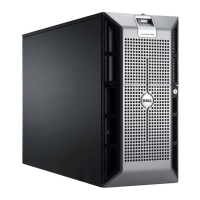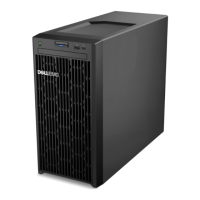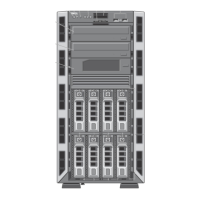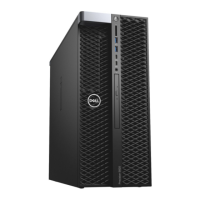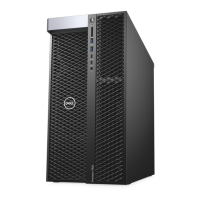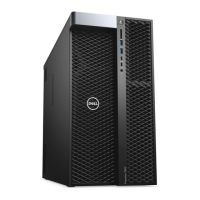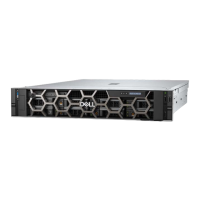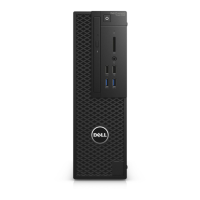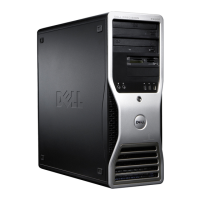




Do you have a question about the Dell PowerVault NX200 and is the answer not in the manual?
Lists keystrokes to access system features like Setup, System Services, and Boot Manager.
Details of front panel components like optical drive, bezel lock, USB, and NMI button.
Explains the system's LCD panel, its backlight colors, and standby mode behavior.
Describes the Home screen's display of user-configurable information and navigation.
Details options within the Setup menu for BMC/iDRAC, error display, and setting the home screen.
Describes options in the View menu, including BMC/DRAC IP, MAC, Name, Power, and Temperature.
Explains the meaning of drive status indicator patterns for RAID-only configurations.
Details the components and indicators found on the back panel of the system.
Provides instructions and precautions for connecting external devices to the system.
Explains the meaning of the link and activity indicators on the NIC connector.
Describes the LED indicator on the power supply and its meaning.
Explains LCD messages, how to view them, and how to remove them.
Explains system messages and provides a table of messages, causes, and actions.
Alerts users to possible problems and prompts for response before task continuation.
Messages issued by system diagnostic utilities when running tests.
Messages generated by systems management software for system status.
Points to safety, regulatory, warranty, Getting Started Guide, and USC documentation.
Explains the system's boot modes (BIOS and UEFI) and how to select them.
Provides steps to enter the System Setup program using the F2 key.
Advises on handling error messages during system boot.
Details the keyboard keys used for navigating within the System Setup program.
Lists main screen options in System Setup, like System Time, Date, Memory, and Processor settings.
Details options for memory size, type, speed, and testing.
Details processor settings like bit, core speed, bus speed, and virtualization.
Explains SATA controller and port settings, including ATA mode and port availability.
Covers boot mode (BIOS/UEFI), boot sequence, and hard-disk/USB drive emulation types.
Details options for integrated devices like SATA controllers, USB ports, and NICs.
Explains how to assign IRQs to devices on the PCI bus and expansion cards.
Details serial communication settings, port addresses, and redirection options.
Describes optional settings for the front-panel LCD and user-defined LCD strings.
Covers power management options for CPU, fans, and memory modules.
Details system and setup password features and TPM security settings.
Options for exiting System Setup, including saving or discarding changes.
Instructions on how to enter the UEFI Boot Manager using the F11 key.
Explains the keyboard keys used for navigating within the UEFI Boot Manager.
Describes the options available in the UEFI Boot Manager screen.
Options for adding, deleting, enabling/disabling, and changing boot order.
Access to System Setup, System Services (USC), and BIOS Boot Manager.
Information on system and setup password features and their security implications.
Details how to assign, use, and delete a system password for security.
Explains how to use system passwords for security and manage password status.
Instructions for assigning and using a setup password to restrict access.
Introduces the Unified Server Configurator (USC) and its features.
Explains BMC configuration, its features, and remote access requirements.
Details entering the BMC Setup Module.
Describes the iDRAC Configuration Utility, its features, and how to enter it.
Provides steps to enter the iDRAC Configuration Utility.
Lists necessary tools for system component installation.
General caution about repairs and servicing.
Instructions for removing and replacing the front bezel.
Steps for installing the front bezel back onto the chassis.
Instructions for removing and installing front bezel inserts.
Explains the purpose of EMI filler panels and how to remove them.
Provides instructions and warnings for opening and closing the system cover.
Instructions for removing and installing the expansion card stabilizer.
Explains the cooling shroud's function and provides instructions for removal.
Information on system's support for hot-swap SATA hard drives.
Steps to remove a hard-drive blank for installing a drive.
Steps to install a hard-drive blank.
Steps to remove a hot-swap hard drive, including safety precautions.
Steps for installing a hot-swap hard drive into its carrier and bay.
Information on the 5.25-inch drive bays for optical drives.
Steps and precautions for removing an optical drive.
Steps for installing an optical drive.
Information on removing and installing the power supply.
Steps for removing the power supply unit from the chassis.
Steps for installing a new power supply unit.
Instructions and warnings for removing and installing the system fan.
Information about supported DDR3 UDIMMs and memory configurations.
Guidelines for optimal system memory performance and configuration.
Sample UDIMM memory configurations and guidelines.
Step-by-step instructions for installing memory modules.
Instructions and warnings for removing memory modules.
General guidelines for installing PCIe Generation 2 expansion cards.
Guidelines for installing expansion cards, including slot priority.
Steps for installing an expansion card.
Steps for removing an expansion card.
Instructions for installing an iDRAC6 Express card.
Information on using internal USB memory keys for boot, security, or storage.
Information on removing and installing a processor.
Steps and warnings for removing a processor.
Steps for installing a new processor, including thermal grease application.
Information on the system battery and replacing it.
Steps for replacing the system battery.
Instructions for removing and installing the chassis intrusion switch.
Steps for removing the chassis intrusion switch.
Steps for installing the chassis intrusion switch.
Instructions for removing the control panel assembly.
Completes control panel assembly removal.
Steps for installing the control panel assembly.
Instructions for removing the SATA backplane.
Steps for removing the SATA backplane, including cable disconnection.
Steps for installing the SATA backplane.
Instructions for removing and installing the system board.
Steps for removing the system board, including component disconnection.
Steps for installing a new system board.
General safety precautions and warnings for servicing the system.
Addresses system halts during startup, boot mode mismatches, and memory configurations.
Guidance on checking external cables and connectors before troubleshooting devices.
Steps to troubleshoot video subsystem issues, including cable checks and diagnostics.
Steps to troubleshoot USB devices like keyboards and mice.
Steps to troubleshoot serial port devices, including cable and device swaps.
Steps to troubleshoot Network Interface Card (NIC) issues, including indicators and drivers.
Procedures for dealing with a system exposed to liquid.
Steps to check component installation and run system board tests for damaged systems.
Steps to troubleshoot system battery issues, including time/date settings.
Steps to identify and troubleshoot power supply issues using indicators.
Checks for conditions that might cause system overheating.
Steps to troubleshoot a faulty fan by reseating its power cable.
Steps to troubleshoot system memory issues, including diagnostics and reseating modules.
Steps to troubleshoot internal USB key detection and functionality.
Steps to troubleshoot optical drive issues, including cable checks and setup options.
Steps to troubleshoot hard drive issues, including RAID configurations and drivers.
Steps to troubleshoot the PERC S300 controller, including diagnostics and configuration.
Steps to troubleshoot expansion card issues, including compliance and seating.
Steps to troubleshoot processor issues, including installation and heat sink.
Guides on using online diagnostics for system assessment.
Overview of embedded system diagnostics capabilities.
Criteria for when to use embedded system diagnostics.
Instructions for launching embedded system diagnostics from USC.
Describes testing options like Express, Extended, and Custom tests.
Details system board jumper settings for password and NVRAM.
Diagram and list of system board connectors.
Diagram and list of SATA backplane board connectors.
Steps to disable system and setup passwords using the password jumper.
Information on how to contact Dell support via phone and online resources.
Lists keystrokes to access system features like Setup, System Services, and Boot Manager.
Details of front panel components like optical drive, bezel lock, USB, and NMI button.
Explains the system's LCD panel, its backlight colors, and standby mode behavior.
Describes the Home screen's display of user-configurable information and navigation.
Details options within the Setup menu for BMC/iDRAC, error display, and setting the home screen.
Describes options in the View menu, including BMC/DRAC IP, MAC, Name, Power, and Temperature.
Explains the meaning of drive status indicator patterns for RAID-only configurations.
Details the components and indicators found on the back panel of the system.
Provides instructions and precautions for connecting external devices to the system.
Explains the meaning of the link and activity indicators on the NIC connector.
Describes the LED indicator on the power supply and its meaning.
Explains LCD messages, how to view them, and how to remove them.
Explains system messages and provides a table of messages, causes, and actions.
Alerts users to possible problems and prompts for response before task continuation.
Messages issued by system diagnostic utilities when running tests.
Messages generated by systems management software for system status.
Points to safety, regulatory, warranty, Getting Started Guide, and USC documentation.
Explains the system's boot modes (BIOS and UEFI) and how to select them.
Provides steps to enter the System Setup program using the F2 key.
Advises on handling error messages during system boot.
Details the keyboard keys used for navigating within the System Setup program.
Lists main screen options in System Setup, like System Time, Date, Memory, and Processor settings.
Details options for memory size, type, speed, and testing.
Details processor settings like bit, core speed, bus speed, and virtualization.
Explains SATA controller and port settings, including ATA mode and port availability.
Covers boot mode (BIOS/UEFI), boot sequence, and hard-disk/USB drive emulation types.
Details options for integrated devices like SATA controllers, USB ports, and NICs.
Explains how to assign IRQs to devices on the PCI bus and expansion cards.
Details serial communication settings, port addresses, and redirection options.
Describes optional settings for the front-panel LCD and user-defined LCD strings.
Covers power management options for CPU, fans, and memory modules.
Details system and setup password features and TPM security settings.
Options for exiting System Setup, including saving or discarding changes.
Instructions on how to enter the UEFI Boot Manager using the F11 key.
Explains the keyboard keys used for navigating within the UEFI Boot Manager.
Describes the options available in the UEFI Boot Manager screen.
Options for adding, deleting, enabling/disabling, and changing boot order.
Access to System Setup, System Services (USC), and BIOS Boot Manager.
Information on system and setup password features and their security implications.
Details how to assign, use, and delete a system password for security.
Explains how to use system passwords for security and manage password status.
Instructions for assigning and using a setup password to restrict access.
Introduces the Unified Server Configurator (USC) and its features.
Explains BMC configuration, its features, and remote access requirements.
Details entering the BMC Setup Module.
Describes the iDRAC Configuration Utility, its features, and how to enter it.
Provides steps to enter the iDRAC Configuration Utility.
Lists necessary tools for system component installation.
General caution about repairs and servicing.
Instructions for removing and replacing the front bezel.
Steps for installing the front bezel back onto the chassis.
Instructions for removing and installing front bezel inserts.
Explains the purpose of EMI filler panels and how to remove them.
Provides instructions and warnings for opening and closing the system cover.
Instructions for removing and installing the expansion card stabilizer.
Explains the cooling shroud's function and provides instructions for removal.
Information on system's support for hot-swap SATA hard drives.
Steps to remove a hard-drive blank for installing a drive.
Steps to install a hard-drive blank.
Steps to remove a hot-swap hard drive, including safety precautions.
Steps for installing a hot-swap hard drive into its carrier and bay.
Information on the 5.25-inch drive bays for optical drives.
Steps and precautions for removing an optical drive.
Steps for installing an optical drive.
Information on removing and installing the power supply.
Steps for removing the power supply unit from the chassis.
Steps for installing a new power supply unit.
Instructions and warnings for removing and installing the system fan.
Information about supported DDR3 UDIMMs and memory configurations.
Guidelines for optimal system memory performance and configuration.
Sample UDIMM memory configurations and guidelines.
Step-by-step instructions for installing memory modules.
Instructions and warnings for removing memory modules.
General guidelines for installing PCIe Generation 2 expansion cards.
Guidelines for installing expansion cards, including slot priority.
Steps for installing an expansion card.
Steps for removing an expansion card.
Instructions for installing an iDRAC6 Express card.
Information on using internal USB memory keys for boot, security, or storage.
Information on removing and installing a processor.
Steps and warnings for removing a processor.
Steps for installing a new processor, including thermal grease application.
Information on the system battery and replacing it.
Steps for replacing the system battery.
Instructions for removing and installing the chassis intrusion switch.
Steps for removing the chassis intrusion switch.
Steps for installing the chassis intrusion switch.
Instructions for removing the control panel assembly.
Completes control panel assembly removal.
Steps for installing the control panel assembly.
Instructions for removing the SATA backplane.
Steps for removing the SATA backplane, including cable disconnection.
Steps for installing the SATA backplane.
Instructions for removing and installing the system board.
Steps for removing the system board, including component disconnection.
Steps for installing a new system board.
General safety precautions and warnings for servicing the system.
Addresses system halts during startup, boot mode mismatches, and memory configurations.
Guidance on checking external cables and connectors before troubleshooting devices.
Steps to troubleshoot video subsystem issues, including cable checks and diagnostics.
Steps to troubleshoot USB devices like keyboards and mice.
Steps to troubleshoot serial port devices, including cable and device swaps.
Steps to troubleshoot Network Interface Card (NIC) issues, including indicators and drivers.
Procedures for dealing with a system exposed to liquid.
Steps to check component installation and run system board tests for damaged systems.
Steps to troubleshoot system battery issues, including time/date settings.
Steps to identify and troubleshoot power supply issues using indicators.
Checks for conditions that might cause system overheating.
Steps to troubleshoot a faulty fan by reseating its power cable.
Steps to troubleshoot system memory issues, including diagnostics and reseating modules.
Steps to troubleshoot internal USB key detection and functionality.
Steps to troubleshoot optical drive issues, including cable checks and setup options.
Steps to troubleshoot hard drive issues, including RAID configurations and drivers.
Steps to troubleshoot the PERC S300 controller, including diagnostics and configuration.
Steps to troubleshoot expansion card issues, including compliance and seating.
Steps to troubleshoot processor issues, including installation and heat sink.
Guides on using online diagnostics for system assessment.
Overview of embedded system diagnostics capabilities.
Criteria for when to use embedded system diagnostics.
Instructions for launching embedded system diagnostics from USC.
Describes testing options like Express, Extended, and Custom tests.
Details system board jumper settings for password and NVRAM.
Diagram and list of system board connectors.
Diagram and list of SATA backplane board connectors.
Steps to disable system and setup passwords using the password jumper.
Information on how to contact Dell support via phone and online resources.
